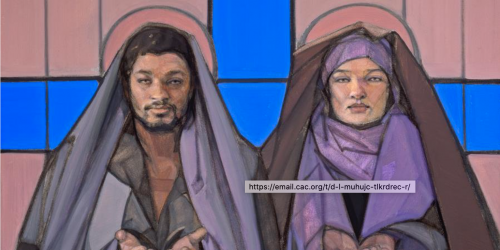Mary Magdalene
Come
and See
Friday, July 24, 2020

At our Universal Christ conference in 2019, artist Janet McKenzie shared her paintings, including her work “Jesus of the People.” In her presentation, she shared how rewarding and difficult it can be to disrupt people’s preconceived notions of who someone is and how they should behave. Our expectations are often bound by class, race, culture, gender, and in this case, religious tradition. Any resistance we might feel to changing our perspective of the role Mary Magdalene played in Jesus’ life or the early church probably stems from that same discomfort of having our preconceived notions challenged. With that in mind, I want to share what Janet McKenzie has to say about her painting, “Mary Magdalene with Jesus, the Christ”—our banner for this week’s meditations.
I painted Mary Magdalene and Christ seated side by side as visionaries and spiritual teachers with their hands open in the universal gesture of prayer—gifts offered and received—as icons of the sacred. Jesus, the Christ, sent to live among us as the Word Made Flesh, and Mary Magdalene, the first one sent to proclaim the resurrection, are models for the community of disciple-companions sent “to the ends of the earth” [Acts 1:8] to tell and become the Good News for all. [1]
Susan Calef, a professor of theology at Creighton University, wrote this commentary about McKenzie’s painting.
The One Sent: Mary Magdalene with Jesus, the Christ. The very words recall the climactic scene of the Gospel of John, that of Mary Magdalene’s dawn encounter with the Secret Gardener. “Mary! . . . Go, tell my brothers and sisters . . .” (John 20:16‒17). For centuries artists have rendered the scene familiar: The Risen Christ stands above and Mary kneels below, her outstretched hand reaching for him as he rebuffs her. “Do not cling to me,” the image speaks.
In striking contrast, The One Sent images not a Gospel scene but a vision, a vision of the Wisdom-Word that dwells in the deep of John’s Gospel. From the opening words “In the beginning” to its climactic return to a garden, the fourth Gospel evokes a new creation, worked and signed upon the world by the Word-Made-Flesh. For those eyed to see by John’s Gospel telling, the image set before us speaks, not “Do not cling to me,” but “Come and see.” [2]
Spend a few moments simply gazing at this painting. Is it possible that “Do not cling to me” may not have been a rebuke but an invitation for Mary Magdalene to see her beloved rabbi and friend from a new perspective? Could it be that the same invitation applies to us as well?